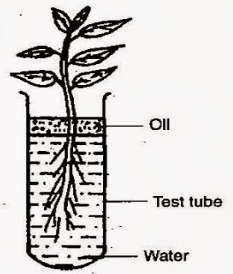Sponsor Area
Transpiration
Study the diagram given below and answer the following questions:
(i) Name the process being studied in the above experiment.
(ii) Explain the process mentioned in (i) above.
(iii) Why is oil placed over water?
(iv)What do we observe with regard to the level of water when this setup is placed in
(1) bright sunlight, (2) humid conditions and (3) on a windy day?
(v) Mention any three adaptations in plants to overcome the process mentioned in (ii)
(i) The process studied is transpiration.
(ii) Transpiration is the process by which plants lose water in the form of water vapour through their aerial parts.
Transpiration helps plants to maintain their temperature.
It also cools the regions around the plant and creates a suction force that pulls water to great heights.
(iii) Oil is placed over water to prevent any water loss by evaporation from the surface of water.
(iv) The level of water will
(1) Reduce in bright sunlight. (due to increased transpiration)
(2) Remain the same in humid conditions. (due to less transpiration)
(3) Reduce on a windy day (due to more transpiration)
( v) Three adaptations in plants to overcome transpiration are:
1. Sunken stomata, e.g. Nerium
2. Fewer stomata
3. Narrow leaves
Some More Questions From Transpiration Chapter
Study the diagram given below and answer the following questions:

(i) Name the process being studied in the above experiment.
(ii) Explain the process mentioned in (i) above.
(iii) Why is oil placed over water?
(iv)What do we observe with regard to the level of water when this setup is placed in
(1) bright sunlight, (2) humid conditions and (3) on a windy day?
(v) Mention any three adaptations in plants to overcome the process mentioned in (ii)

Mention the effects of two individuals in a street fight on the following organs by the autonomous nervous system (one has been done for you).
Organ
Sympathetic nervous system
Para-sympathetic nervous system
eg Lungs
Dilates bronchi and brochioles
contricts bronchi and bronchioles
1) Heart
2 Pupils of the eye
3 . Salivary
2 Pupils of the eye
3 . Salivary
(ii) List four major activities of the Red Cross.
Name the following:
(ii) A plant with sunken stomata.
(ii) A plant with sunken stomata.
There are five sets consisting offive terms given below. In each set, there is a word
which is an odd one. For each of these sets, write down the category of the group
having identified the odd one out, as shown in the example:
Example: (0) cell wall, vacuole, centrosome, plastids, mitochondria
S.no
Category
Odd one
0
Organelles of plant cell
Centrosome
(i) Blinking, Knitting without looking, Smiling, Blushing, Crying
which is an odd one. For each of these sets, write down the category of the group
having identified the odd one out, as shown in the example:
Centrosome
Choose the correct answer to the following statements out of the three choices given
after each statement.
Loss of water as droplets from hydathodes is called
after each statement.
Loss of water as droplets from hydathodes is called
Account for the following:
(iii)The leaves of certain plants roll up on a bright sunny day.
Identify and name the following processes/terms from the statements given below:
(iv)The loss of water from InJured parts of a plant.
(iv)The loss of water from InJured parts of a plant.
Sponsor Area
Mock Test Series
Mock Test Series





